My story of ejection from a T-6 Texan II

Our flight was scheduled for an 09:15L takeoff with an 08:00L briefing time. It was supposed to be a combined Contact and Instrument profile. Specifically, this sortie would have included instrument approaches and VFR patterns as well as instrument area maneuvers, in addition to stalls and dual-only maneuvers. It was the sixth ride in my instructor-pilot (IP) training in a T-6 Texan II at Sheppard Air Force Base (AFB).
Thirty minutes before briefing time, the weather conditions appeared to be marginal for visual patterns and I was not sure if they would improve. We hadn’t received any pilot reports on the weather conditions because no one was yet airborne. I decided to change the profile by starting with an IFR departure, practice instrument approaches at KLAW (Lawton OK, about 40NM north of Sheppard AFB) and then, weather permitting, try to go to the military operating area (MOA) and fly both visual and instrument maneuvers. The return to KSPS (Sheppard AFB) was planned to be via an instrument procedure.
This was my second assignment to Sheppard AFB as a T-6 instructor pilot for the ENJJPT (Euro NATO Joint Jet Pilot Training) program. The instructor I was to be flying with is a friend of mine; five years prior, we had flown together often on my previous ENJJPT assignment. Before to this sortie, I had accumulated about 1,300 hours flight time in the T-6, so this training was more of a refresher.
Briefing, ground ops and departure were uneventful. During the short navigation to KLAW, there was constant chatter about possible flying status changes, worsening weather conditions and possible recovery windows in case of a weather recall. The Flight Operations Supervisor’s (OPS-SUP) approach was standard, instructing us to continue flying the missions as planned for there were no major weather phenomena other than a ceiling reduction. The Supervisor of Flying (SOF), a higher authority than the OPS-SUP, took a much more conservative approach. The SOF was considering a possible weather recall for all airborne T-6s and T-38s due to potential weather deterioration. The SOF won the tug-of-war and all the aircraft, including ours, were recalled for an immediate landing. As expected, RAPCON (Radar Approach Control) frequency became overcrowded. Obviously, the T-38s are given landing priority due to their limited fuel endurance, while the T-6s received long vectors or extended time in holding. In our case, this was not a problem as we had only been airborne for 20 minutes. We could count on at least 45 minutes of playtime before reaching bingo fuel (the lowest possible fuel remaining before being forced to divert to the intended divert airport). All was going as planned until about ten minutes prior to being established on final for an ILS at Sheppard AFB. Unexpectedly, we were told, “Turn right heading 090°, climb at 6000ft and DIVERT.” My instructor/friend started to protest, asking why we needed to divert so soon, since we had enough fuel to stay in holding and wait. The answer, which sounded a little too hasty, went something like, “We have too many T-38s to recover, SOF decided all T-6s need to divert.” We thought it absurd yet in our utter disbelief, we and 13 other T-6s diverted to KAFW (Fort-Worth Alliance) where we landed without incident.
After refueling and a short lunch break, we decided to take off and try to complete the mission doing the area work we had skipped during the previous flight. The weather conditions had not changed much but a bad front was expected in the afternoon carrying the risk of severe thunderstorms. Since the expected timeline for the weather was beyond our flight window, we thought it all looked good.
Navigation to the working area was smooth, except that a large storm cell was already forming to the east and moving in our direction. Area work proceeded quickly and uneventfully. Up to that point, the instructor in the rear cockpit had not touched the controls. (Due to my previous experience as a T-6 IP, there was not much to correct in my performance.) I transferred aircraft control to allow him to set up the unusual attitude recoveries for me. He was glad to finally have some stick-time. The following two minutes passed while he did some cloud-chasing over the cumulus that were slowly forming. Meanwhile, I was setting up my iPad for the instrument procedure we would fly for the return to base. He was flying around the clouds doing nothing extreme nor did he pull many Gs. I was deliberately paying little attention to our flight parameters since I had complete confidence in his ability to handle the aircraft.
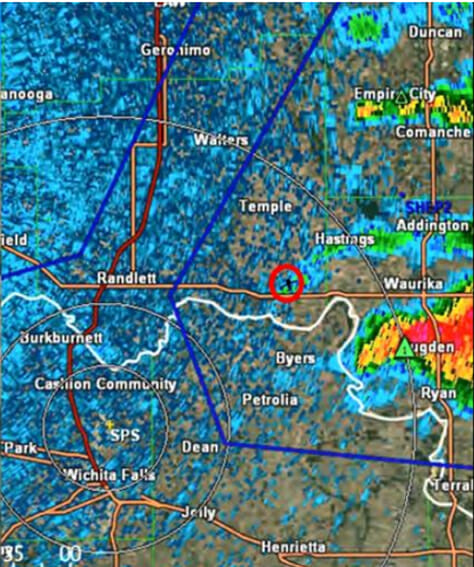
Blue lines: Shep 2 MOA
Red circled: position of the aircraft when the incident occurred
Suddenly, I felt light in my seat and casting a glance at the altimeter, I realized we were at 13,400ft., only 100ft. below the top of our assigned airspace and no more than 100-200ft. above a thick gray cumulus cloud. Without much alarm, I broke the silence in the cockpit with, “Hey, check the area.” A moment later, my brain was still trying to justify that sensation of a light seat and I was looking for answers in the airspeed indicator and the ADI. To my enormous surprise they were reading 65KIAS and 60° nose up, respectively. At that point I knew well that the actual conditions were not ideal to keep the airplane flying, (Slow flight speed with no-flaps is 90-95KIAS, spin entry speed is 80KIAS). Honestly, I would have expected something simpler as an unusual attitude to practice the recovery, but I was still convinced that the conditions were intentional. The reality, however, was different. My instructor was completely disoriented by the absence of a discernible horizon, not realizing how pronounced the pitch attitude was nor how low the airspeed was. In these conditions it is possible to encounter a power-on stall or, even worse, an inverted spin induced by the pronounced torque effect in MAX power, combined with slow speed and high angle of attack. While trying to bring the aircraft back to level flight, he probably accepted entering the cumulus clouds. Normally, we are precluded from entering the clouds except during the departure to or recovery from the area – but not while executing maneuvers. Under those conditions however, I think he accepted having to violate this rule in order to recover full control of the aircraft.
I remained calm, already imagining the good-natured jokes that would follow this flight for his somewhat gross error. I still expected, although in IMC, the instructor would regain control of the aircraft and return to VMC as soon as possible. Unfortunately, that’s not how it went, the situation became more complicated. My instructor was now cussing in the back seat, fighting to regain control of the aircraft. Not even two seconds after entering the clouds, the airplane suddenly entered an inverted spin. It was like riding the end of a whip. Under negative G-forces, bewildered and still intent on figuring out what was happening and why, I spent the next six seconds listening, in this order – two seconds of cursing from the IP, two seconds of deafening silence, followed by two seconds of, “BAILOUT, BAILOUT, BAILOUT,” commanded from the rear cockpit instructor pilot. I describe his tone between pained and imperiled. Well yes, I had just heard the three infamous little words that we always brief before flight but that you hope you never have to hear in flight. An order which, of course, is given only by the aircraft commander (providing they are conscious). The fact is, just upon hearing those words, my blood seemed to freeze in my veins. Something didn't add up, it seemed a hasty decision – I was not ready. In a millisecond, I cast my eyes upon the altimeter reading 12,000ft, regained my clarity and coolness, and with remorse for something I would never have dreamed of doing, I shouted, “NO WAIT,” over the intercom.
In retrospect, I keep telling myself that maybe I shouldn't have. The aircraft commander on that occasion was not me and, as briefed, when the order is given, there is no questioning it. But the situation was also very unusual, extreme in some ways. It was still unclear what was going on, and, most importantly, we were still at 12,000ft. Minimum ejection altitude for the T-6 in an out-of-control situation is 6,000ft AGL (7,000ft MSL in our local area). As it happened, the instructor, once he heard my request, did not pull the ejection handle. Instead, he replied with a peremptory, “You have the aircraft.”
As he confirmed to me later, he was completely crushed against the canopy with his head bent down and totally disoriented by the spin, the clouds, and the negative Gs. He was not even able to read the instruments, so had absolutely no chance to control the airplane and the ejection was the only viable course of action given his condition. My words gave him some hope. He correctly thought that the condition I was in was better than his, and he promptly relinquished the aircraft control to me hoping I could do something.
Having taken control of the aircraft, I immediately applied the proper spin recovery procedure, set the engine power to idle (it was still in MAX), and tried to neutralize stick and rudder. I say tried because even though I was firmly strapped into the seat, due to lateral and negative accelerations, my torso tilted to the left and my legs floating above the pedals. In addition, being in IMC gives a very strong sense of disorientation so, while everything around me was dancing, I tried to move the stick into the position that I perceived as neutral at that moment. Simultaneously, I tried to find some grip on the pedals to keep them centered but with less than satisfactory results on the latter task. Up to this point, note that no more than 12 seconds had passed since entering the cloud. I had been in control of the aircraft for no more than five or six seconds when suddenly, the same pained and imperiled voice I heard before, broke the silence again with an even more peremptory tone and yelled again, “BAILOUT, BAILOUT, BAILOUT!” In that moment, even if I had been successful in achieving controlled flight (I had not), he probably had no idea what was going on and what I was trying to do to solve the situation. Almost certainly he did not have any idea how much altitude we had left before impact since he was not able to read the instruments. It became clear to me that I didn’t have any more time to try to recover the aircraft to level flight, that it would not be possible to avoid the bailout this time and that indeed, I must waste no more time, assume the proper pre-ejection position, and pull that handle ASAP.
The ejection selector switch in the rear cockpit was set on BOTH so whomever had pulled their handle first would have resulted in both pilots being ejected with the proper engineered sequence. I clearly remember how it was impossible to get my back straight vertical, because of the induced centrifugal forces, so I had to accept an ejection in less-than-ideal body position and face the possible consequences later. I was barely able to touch the ejection handle with the fingertips of my right hand when a sudden flash of light on the right bottom of my seat announced that the launch sequence had already been activated from the rear seat. This was followed by three seconds of dull explosion bangs, gray vision and finally a tug – a straight pull over my shoulders – the parachute had opened. It wasn’t as hard as I expected – much more passive, in fact. After the flash of light, the next sharp image I recall was the perfectly inflated canopy above my head shrouded by the fog in which I was immersed. After the chute check, I performed a quick body check. I only had a sharp pain in my right ankle, like a sprain. The right boot however was dirty on the right side, so I guessed it was blood and probably the pain was from some broken bone. Aside from that, I seemed to be fine, only feeling breathlessness and agitation in silence. In an unreal silence, I was immersed in a giant grey cotton ball with the survival kit attached by rope, 12 feet below my harness, that wouldn’t stop swirling and twisting around my legs.

I don't know how long the descent lasted but I estimate at least eight to ten minutes since we had ejected around 11,000ft MSL, but it seemed like an eternity – an eternity in hell! The gusts inside that cumulus cloud were making the parachute roll left and right with me underneath rolling in the opposite direction. At the same time, I was kicking trying to untangle my feet from the cord of the survival kit. After a few minutes, ice was forming on the parachute lines. I was soaked and cold. It was like being inside a washing machine nauseating me with all the spinning and rolling. In short, it was a nightmare with my only hope that it would soon end. To try to stabilize the descent with improved steering, I pulled the red Lemoigne lanyards designed to open the two small slots on the rear side of the canopy control, but it didn’t make a noticeable improvement. I only had to wait and pray that the parachute would remain inflated and that the cloud bottom was not very low. I hoped to have at least some time to check the ground and prepare for the landing.
When I finally emerged from the cloud (I estimate around 2000ft AGL), the descent became immediately smoother and more stable. I could start thinking straight again and my first thought was for the other pilot. I looked below me for his parachute. Theoretically, he was sequenced to bail out first, but he was not there. I feared the worst – that something may have gone wrong with his ejection or that the parachute might have not opened at all. I spotted the two white drogue chutes still attached to the ejection seats just about to land, but I still did not see him.
Meanwhile, I removed the oxygen mask from the helmet, discarded it as prescribed, and started looking for a possible landing area. Everywhere around me seemed to be grassy and flat, apparently nothing to be too worried about, so I just let the wind push me in the direction it was blowing. Probably a minute later, I finally saw the other pilot coming out of the clouds, well above my position. Surely he must have caught some thermal that pushed him upward into the clouds. I didn't know how he was doing yet, but just seeing his figure gave me great relief and I could finally begin to focus on the landing. I forced myself to draw back from memory all the classes and rehearsals of how to do a good parachute-landing fall that I had learned 20 years earlier as an ENJJPT student at Sheppard AFB. The refrain came back to mind as if I had learned it the day before and I repeated it to myself like a mantra: “… eyes on the horizon, feet and knees together, bend your knees …”
I tried to get a better sense of where exactly I was about to land. Much to my dismay, I found that the landscape had changed substantially. The endless expanses of green grass were gone and I now saw, in the direction the wind was pushing me, some brown ponds and a powerline running along a dirt road. The latter certainly worried me more than the former. At only a few hundred feet above the ground with not much time to react, I started pulling the parachute line on one side, trying to steer to have the wind at my back hoping to go beyond the obstacles. We were trained that if you land over powerlines, you should first try to offer the skinniest possible profile (like an Egyptian figure) in order not to touch multiple lines and be electrocuted and with a good chance the chute will get stuck with you hanging underneath. If you land in water, you could become stuck in the mud, or if deep enough, you could drown for so many reasons; after losing contact with the surface, because your wet clothes and boots become heavy pulling you down, or simply because the parachute covers the surface above your head not allowing you to come up for breath. While thinking of all these ill-fated possibilities, I went back to focusing on the mantra, staring at the horizon with my feet and knees together and slightly bent. The landing was soft, on my back (not on my flank as the training would have had it), over wet and thick grass. I quickly disconnected the parachute before the wind could inflate it again and pull me over. I was immediately on my feet, standing, breathing deeply, with my heart beating hard … yet smiling – smiling like someone would smile who had been about to lose everything but is instead untouched. The powerline was about 20 feet from my position and the pond no more than ten. I had been lucky, I thought to myself. Despite all that had just happened, I really felt lucky. It was finally over. My right boot was not bloody, it had been burned by the rocket pack of my ejection seat.
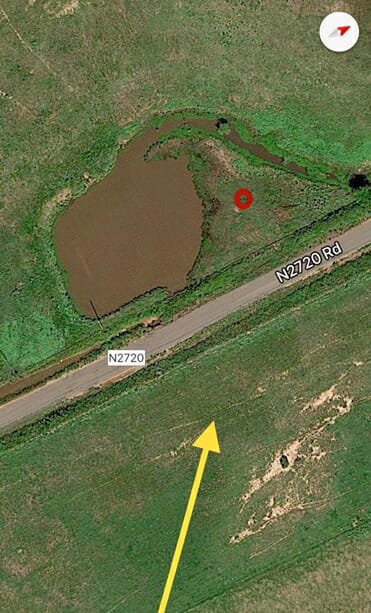
Red Circle: Actual point of landing
Yellow line: direction of the parachute flight before landing
I looked up to see the other pilot was still in the air. I followed his flight while I grabbed my cellphone from a side pocket and turned it on. I felt the need to call my wife. I wanted to hear her voice even before alerting the rescue team. Incredibly, a siren immediately blasted from the phone speaker emitting a warning message on the screen. The smile disappeared from my face when I read: “TORNADO WARNING IN YOUR AREA, TAKE SHELTER NOW!!!!” When I gave a closer look to the weather surrounding me, I could identify various rain showers around me. The sky was dark and the wind was howling. Unfortunately, I had to reconsider the call. The day was not over yet, and in the middle of where I found myself in Texoma, there was nowhere to take shelter.
Eventually, the other pilot landed about a quarter of a mile from me with no major issues. We ran towards each other, we hugged, we cried, we laughed – we were simply happy to be alive.
We were first found by a couple of local farmers who had been attracted by the sight of parachutes. We were then joined by a police officer who took us to the aircraft-impact site, about six miles away from our location. The military fire crews and the ambulances were waiting for us. Fortunately, the T-6 crash did not cause any damage to property or persons.
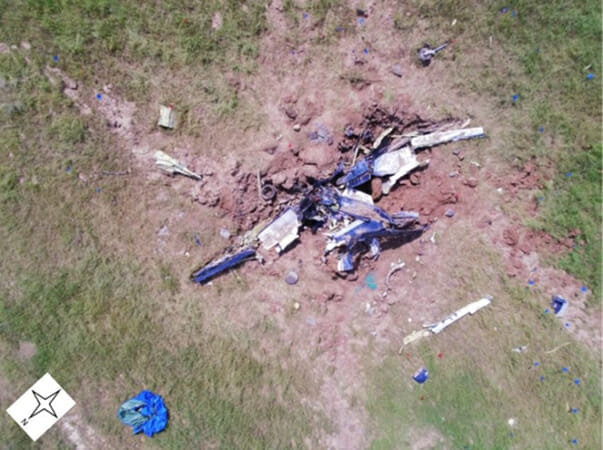
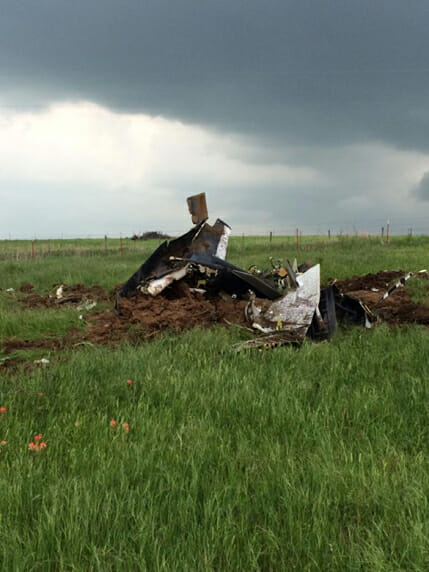
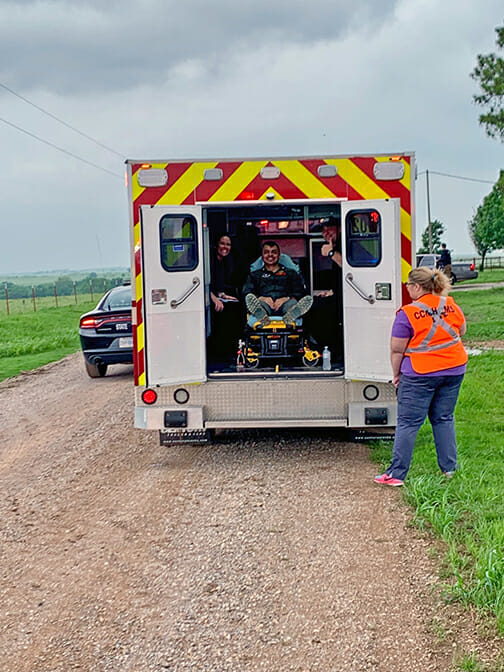
I spent the rest of the evening at the base hospital going through various investigations, tests, sample analyses and dozens of x-rays. In the end, it all turned out well with nothing broken, only a slight sprain in my right ankle and dozens of tiny abrasions around my neck, arms, and hands due to the fragments of the explosive cords from the canopy. (In case you wonder, yes, I was wearing gloves and my flight suit was not rolled over my arms.) I also found marks on my chest, probably from tiny hot metal shards from the canopy explosion that penetrated tissues. It took weeks for the skin to heal.
I had to wait two weeks before I would be approved to fly again. The safety investigation board attributed the cause of the accident to an “unintentional inverted spin induced by bringing the aircraft in those flying conditions that the aircraft manual describes as very favorable to produce an inverted spin. A severe spatial disorientation, mainly induced by being in IMC conditions, caused the crew to decide to eject, no further actions were taken against them.”
The total elapsed time from losing control of the aircraft to the ejection had been a mere 20 seconds. An unbelievable shame is that the aircraft eventually recovered from the inverted spin after we ejected. This experience has obviously been seared into my mind but has not for a single moment bent my passion for flying and my desire to jump into the seat of an airplane every time I have the chance to fly. Currently, I am still at Sheppard AFB Texas flying the mighty T-6 Texan II.




















































































































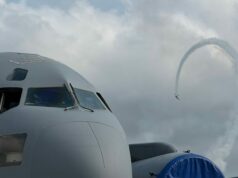
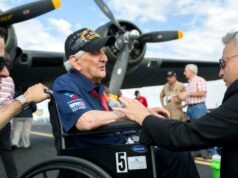


So cool to see the whole story written all at once. What a wild day.
We miss flying those Texans. JOE spin one for us!